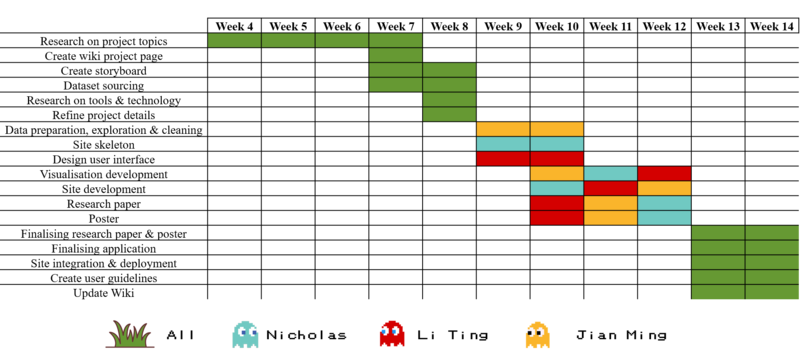Difference between revisions of "Group07 proposal"
| Line 409: | Line 409: | ||
<center>[[Image: storyboard-1.png|500px]]</center> | <center>[[Image: storyboard-1.png|500px]]</center> | ||
|| | || | ||
| − | + | <center><b><u>Home</u></b></br></center> | |
| + | The Home page aims to fulfil the following goals: | ||
| + | To create awareness for HIV by providing a general description of the problem/issues with regards to the virus today. | ||
| + | Other information like the project motivation and objectives will be displayed on this page as well aid users in understanding the project context. | ||
| + | |||
| + | Users can begin their exploration of the project by either clicking on “Map Breakdown”, “Time Series” or “Treatments”. Each of these pages serve a different purpose. | ||
| + | |||
|- | |- | ||
| | | | ||
<center>[[Image: storyboard-2.png|500px]]</center> | <center>[[Image: storyboard-2.png|500px]]</center> | ||
|| | || | ||
| − | + | <center><b><u>Map Breakdown</u></b></br></center> | |
| + | The Map Breakdown module will comprise of the following: | ||
| + | |||
| + | 1. Filter by Year and States | ||
| + | |||
| + | 2. Choropleth map | ||
| + | *A detailed U.S. map depicting the condition of HIV infected rate filtered by year(s) and state(s). The infected rate refers to the number of HIV cases. | ||
| + | *Users will be able to infer the severity of the virus infected per state by looking at the colour tone. (Lighter tone being the less infected and darker tone being the more infected state). | ||
| + | |||
| + | 3. Line chart | ||
| + | *Upon clicking on a specific state(s), the death rate (in line chart) will be displayed in accordance to year(s). | ||
| + | |||
| + | 4. Summary | ||
| + | *This section will consist of a brief statement of the main points from the visualization. | ||
| + | |||
| + | 5. Animation bar | ||
| + | *The animation bar will be tagged to the choropleth map. Upon clicking on the play button, users will be able to see the changes in colour tone of the infected cases on the map across the year(s). | ||
|- | |- | ||
| | | | ||
<center>[[Image: storyboard-3.png|500px]]</center> | <center>[[Image: storyboard-3.png|500px]]</center> | ||
|| | || | ||
| − | + | <center><b><u>Time Series</u></b></br></center> | |
| + | The Time Series module will comprise of the following: | ||
| + | |||
| + | 1. Filter by Race and Year | ||
| + | |||
| + | 2. Line chart | ||
| + | *Display the number of HIV cases throughout the year(s) by race(s). | ||
| + | |||
| + | 3. Age-sex pyramid | ||
| + | *Display the number of HIV cases within each age group by gender. | ||
| + | |||
| + | 4. Summary | ||
| + | *This section will consist of a brief statement of the main points from the visualisation. | ||
|- | |- | ||
| | | | ||
<center>[[Image: storyboard-4.png|500px]]</center> | <center>[[Image: storyboard-4.png|500px]]</center> | ||
|| | || | ||
| − | + | <center><b><u>Treatment</u></b></br></center> | |
| + | The Time Series module will comprise of the following: | ||
| + | |||
| + | 1. Filter by State and Year | ||
| + | |||
| + | 2. Group bar chart | ||
| + | *This chart will allow the users to understand the types of treatments given to the patients by year(s) and state(s). | ||
| + | *Patients either received treatment, no treatment or achieved viral suppression. | ||
| + | |||
| + | 4. Summary | ||
| + | *This section will consist of a brief statement of the main points from the visualization. | ||
|- | |- | ||
|} | |} | ||
Revision as of 19:27, 1 March 2020

| Proposal | Poster | Application | Research Paper |
Contents
Project Motivation
Problem
HIV/AIDS, a chronic manageable disease, is a global pandemic that has created unprecedented challenges for physicians and health infrastructures. There is no cure for HIV yet. However, treatment can control HIV and enable people to live a long healthy life.
Over the years, there have been substantial media coverage and resources to educate the public on the danger of HIV and how to avoid being infected with it. These resources can be found from organizations such as the Ministry of Health (MOH), Centers for Disease Control and Prevention (CDC)World Health Organisation (WHO). However, these websites tend to cluster descriptive critical information in their visualizations and in a table format which makes information difficult for the reader to grasp.
Motivation
Among all the deadly viruses, for this IS428 project, our group will focus our resources on the virus – Human Immunodeficiency Virus aka HIV in the United States (U.S.) context.
The reasons are as follow:
- According to WHO, “Major UN study finds alarming lack of knowledge about HIV/AIDS among young people.”
- According to Avert, “There is no cure for HIV, although antiretroviral treatment can control the virus.”
- According to HIV gov, “HIV has cost America too much for too long and remains a significant public health issue and more than 700,000 American lives have been lost to HIV since 1981.”
Due to the absence of a cure, there is a higher priority to the insights of HIV as there is a possibility of this virus escalating into a global epidemic. Furthermore, the general public has a preconceived notion that they will less likely be infected by HIV which explains the little attention given to the virus. However, low risk does not equate to no risk. While this virus might not be a global epidemic yet, the situation is still severe in the U.S. and this issue should be addressed. This visualization project will also serve as an educational tool to educate the risk about HIV and complement the 2019 U.S. plan in ending the HIV Epidemic by 90% in 2030 with the help of data and visualization tools.
Objectives
With the comprehensive dataset available on Centers for Disease Control and Prevention, we will be focusing on the objectives below:
- To explore geospatial distribution of HIV cases.
- To gain insights on the trend of HIV cases and the fatality rate over the years.
- To understand the treatment given to the HIV patients across different states over the years.
- To gain insights on the demographics of the reported HIV patients.
Dataset
Below are the data sets that TEAM HIVA will be using for the visualization:
| Dataset/Source | Data Attributes | Rationale Of Usage |
|---|---|---|
|
Source: Centers for Disease Control and Prevention |
|
|
|
Source: Centers for Disease Control and Prevention |
|
|
|
Source: Centers for Disease Control and Prevention |
|
|
|
Source: Centers for Disease Control and Prevention |
|
|
Background Survey of Related Work
| Learning Points | Area of Improvement | Solution |
|---|---|---|
|
|
|
| Learning Points | Area of Improvement | Solution |
|---|---|---|
|
|
|
|
| |
|
| |
|
Could possibly combine the other less occurring countries into one combined field. | |
|
|
| Learning Points | Area of Improvement | Solution |
|---|---|---|
|
|
|
| Learning Points | Area of Improvement | Solution |
|---|---|---|
|
|
|
| Learning Points | Area of Improvement | Solution |
|---|---|---|
|
|
|
| Learning Points | Area of Improvement | Solution |
|---|---|---|
|
|
|
| Learning Points | Area of Improvement | Solution |
|---|---|---|
|
|
|
Reference List
Problem, motivation and objectives:
- Major UN Study Finds Alarming Lack of Knowledge About HIV/AIDS Among Young People. (2010, December 7). Retrieved February 28, 2020, from https://www.who.int/mediacentre/news/releases/who56/en/
- Is there a cure for HIV and AIDS? (2019, July 17). Retrieved February 28, 2020, from https://www.avert.org/about-hiv-aids/cure
- Content Source: HIV.govDate last updated: February 26, 2020. (2020, February 27). What is 'Ending the HIV Epidemic: A Plan for America'? Retrieved February 28, 2020, from https://www.hiv.gov/federal-response/ending-the-hiv-epidemic/overview
Dataset:
- AtlasPlus - HIV diagnoses. (n.d.). Retrieved February 28, 2020, from https://gis.cdc.gov/grasp/nchhstpatlas/tables.html
- AtlasPlus - HIV deaths. (n.d.). Retrieved February 28, 2020, from https://gis.cdc.gov/grasp/nchhstpatlas/tables.html
- AtlasPlus - HIV prevalence. (n.d.). Retrieved February 28 2020, from https://gis.cdc.gov/grasp/nchhstpatlas/tables.html
- AtlasPlus - Receipt of HIV Medical Care. (n.d.). Retrieved February 28, 2020, from https://gis.cdc.gov/grasp/nchhstpatlas/tables.html
- AtlasPlus - HIV Viral Suppression. (n.d.). Retrieved February 28, 2020, from https://gis.cdc.gov/grasp/nchhstpatlas/tables.html
Background survey and research:
- World Health Organization. (2019). MERS situation update [PDF file]. Retrieved February 26, 2020, from http://applications.emro.who.int/docs/EMCSR246E.pdf?ua=1
- Local Burden of Disease – HIV. (n.d.). Retrieved February 28, 2020, from https://vizhub.healthdata.org/lbd/hiv
- HIV Worldwide 1990-2013 Visualization. (n.d.). Retrieved February 28, 2020, from https://vizhub.healthdata.org/hiv/
- HIV Aids situation in Southeast Asia. (n.d.). Retrieved February 28, 2020, from https://public.tableau.com/profile/to.huy#!/vizhome/PersonalCapstoneProject2-VisualisationofHIVAIDSSituationinSouth-EastAsia/HIVAIDSsituationinSouthEastAsis
Technical Challenges & Mitigation
Brainstorming
The following charts were proposed during our brainstorming session to fulfil the objectives of the project. The ideas were gathered after the background research on the related work from credible sources.
Storyboard
Project Timeline
Comments
Please feel free to leave your comments here! :D

















